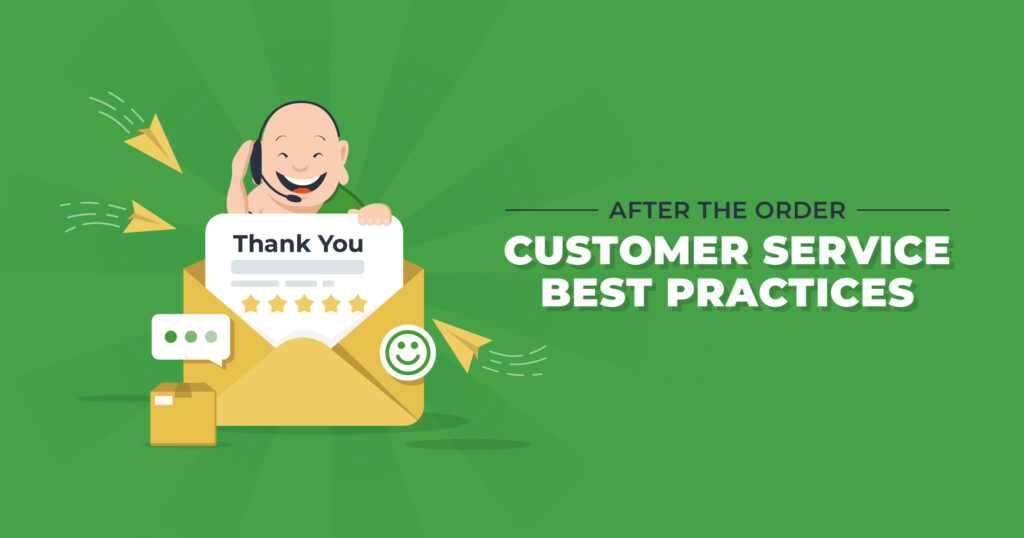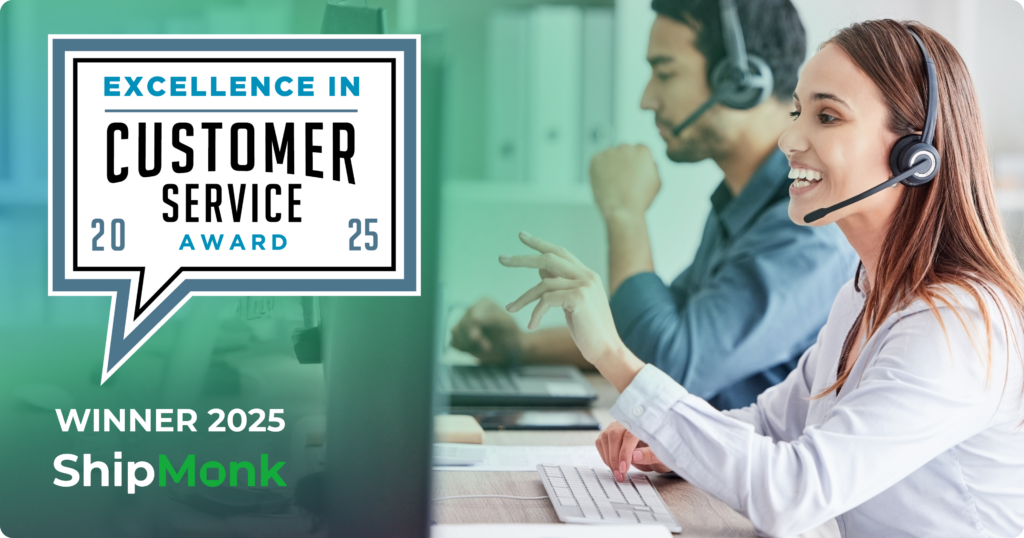You’ve worked hard to develop your product, build a customer-friendly website, set up your supply chain and fulfillment operations, and develop a brand-building marketing plan. Hmmm, what are you forgetting?
We know there’s a lot to worry about, but we hope you’ve given some thought to what happens after those orders start rolling in. How are you going to handle a wrong address, or a lost package? What if your fulfillment center picks and packs the wrong item? What if there’s a quality issue with one of your products, or a customer simply needs a different size? Customer service isn’t just about solving complaints. In fact, if managed properly, it’s about preventing most complaints from happening in the first place. And that’s what we’re going to cover today.
Customer Service 101
The number one rule of customer service has been around awhile. It’s called The Golden Rule: treat others the way you would like to be treated. To be any good at it, you have to put yourself in your customer’s shoes. Think about the times you’ve ordered online. What were your pain points or frustrations? Were you irked at being interrupted repeatedly by email signups or having to create an account in order to browse? Have you ever panicked because you hit the buy button and nothing happened? Ever spent waaay too much time trying to find an answer to a product question or figure out how to return something?
For virtually every business, customer service is a cost center. The objective should be to keep those costs low. But hiding your contact info and scrimping on staff hours and technology isn’t the answer. The second rule of customer service could be taken straight from the doctor’s oath: First, do no harm. By that we mean, don’t make it harder for your customer than it needs to be. Customers are increasingly willing to solve their own problems if you let them. But if you make it hard, you’re adding to your customer service issues rather than reducing them.
Customer Service Best Practices
1. Provide helpful information wherever it’s needed. This includes detailed product descriptions, multiple photos, instructions (if necessary), reviews, and sizing information on your product pages so customers can make informed decisions. Technically, product descriptions don’t fall under the customer service umbrella, but if they prevent calls and product returns, they’re lowering customer service costs, and making it easier for your customers to shop — a win-win. Still getting questions? Consider adding a live chat function with a product expert. (This assumes that you have product experts, not bots, who actually know what they’re talking about).
2. Enable self-service. Help your customers help themselves. There are several ways to do this, and they all should be accessible by desktop, mobile and on your app (if you have one).
- A knowledge-base support platform, such as Zendesk, HelpDocs, or Zoho Desk, enables customers to search a private database for answers to the most frequently asked questions.
- An automated claims portal, such as the service offered by MonkProtect, ShipMonk’s package protection program, enables customers to initiate returns on their own. They fill in the reason for the return, and the system automatically pushes them through for review and approval. You set the parameters, and your customer service team only reviews the requests that require attention.
- Provide an order status page and an order tracking number once the order has shipped. The MonkProtect post-purchase suite also includes a branded tracking page, so participating customers don’t have to go to a carrier’s website to track their orders.
3. Be available. When customers do need your help, they should be able to find it quickly. Put links to your support page in your website header, mobile and app menus so it’s easy to find. Offer several methods of support, including phone, email, and chat. Include it in your emails, tracking pages, and all post-order communications.
4. Respond quickly. If your call center, chat lines, and inbox aren’t monitored 24/7, let customers know when they can expect a response. Social media comments or direct messages should be answered as quickly as possible. And we don’t have to remind you to respond in a polite, respectful manner …or do we?
5. Centralize customer interaction data. Keep track of customer interactions in a centralized database, and track the progress of every ticket until it is resolved. That way nothing falls through the cracks. There are plenty of ecommerce helpdesks and customer service solution providers including Gorgias, Gladly, and Zendesk, that make this easy. Information collected should include the number of contacts, time of contact, concern, related product or order number, customer contact info, order history, your responses, and the current status of the open ticket. Centralizing this data allows anyone on your customer service team to step in at any time to resolve or escalate the issue, and it cuts down on the number of times your customer has to explain the issue.
6. Listen to your customers. Does a database of complaints sound like the fifth circle of hell? You’re looking at it all wrong. Customer complaints are actually the best, most honest source of feedback about your business that you’re ever going to find. Tracking customer service contacts by issue allows you to identify problem products, problem customers, or problems with fulfillment accuracy, packaging, or shipping carriers. Product reviews and post-purchase satisfaction surveys are also good sources, as long as someone is reading them. Hello? Your customers are trying to help you, so let them!
7. Act (when you can). If there’s a problem with a particular product, fix it or discontinue the product. Consistently damaged deliveries? Test different packing materials or switch shipping carriers. Consider adding a parcel protection option at checkout, like MonkProtect. Customers complaining of slow deliveries? Consider switching to a 3PL that can guarantee 2-day shipping to anywhere in the continental U.S. Once you know when your busiest times for customer calls or chats are going to be, or which of your social channels gets the most engagement, you can staff up for them. If you don’t act on the information you receive, the complaints will keep coming in.
8. Over Communicate. It may seem like you’re stating the obvious (Of course we got your order! No, it hasn’t shipped yet, you just placed it!) but keeping your customer in the loop at every stage of the order fulfillment process reduces their stress and your customer service interactions. Our numbers indicate that the average customer checks their tracking page 7 times per order. That’s a lot of avoided interactions. It also means there’s no such thing as communicating too much. Transactional emails and texts can be automated, so there’s no reason not to send them.
Confirmations and Notifications
At a minimum, your customers should receive two important transactional emails: an order confirmation and an expected delivery date (once you have one). Email and marketing platforms, such as Constant Contact, MailChimp or HubSpot, allow you to design these emails to fit your brand, and automatically send them within a specified timeframe after the order is placed. They integrate with third-party apps like Shopify, Stripe, and Zapier, and can sync email lists from different sources, so you don’t have to do a thing once they’re set up.
Order Confirmation Email
Order confirmation emails have the highest engagement rates of any type of email: 65% open rates and 17% click-through rates. Customers expect a notification that confirms what they ordered, the amount charged, the shipping address, and that you’ll be back in touch when their order ships. Here are a few tips on how to create a good confirmation email:
- Make it easy to skim, so the important information is easy to find, and other information is broken up into digestible sections.
- List all the items in the order, number of units, sizes, colors, unit price, discounts, taxes, total amount paid and shipping address.
- Thank the customer for their order. Keep it friendly and express your brand character. It’d be a shame to not take advantage of a 65% open rate. Here’s an example of a confirmation email I received recently:
- Include a link to their order status page so they can track its progress themselves.
- Don’t let your marketing team overload this email with promotions and incentives to order again. There’s a time and a place for generating repeat purchases, but it’s usually sometime after the customer has received their order.
- Links to helpful information, however, such as care instructions, loyalty programs, and social media links are perfectly acceptable and further your brand.
- Include customer service contact information, in case something is wrong with the order.
- Make sure the subject line clearly refers to the order, so it doesn’t get mistaken for a promotional marketing email.
Order Confirmation
Sometimes it takes a beat for orders to show up in your system, but that’s no reason to leave your customer hanging. If you can’t (or don’t want to) send an immediate confirmation email, many small businesses and large ones (Amazon included) redirect buyers to an order confirmation page as soon as they hit the “buy” button. The message might say nothing more than, “Thanks for your order, we’ll get back to you soon,” but at least the customer knows the order went through. You can include links, next steps and order information, but the problem with a pop-up window is that it’s temporary. You can’t really count on your customer reading it, and once they close it, it’s gone forever. You should always follow up with an email that has all the important information they might want to save.
Shipping Notification Email
The message is simple: your order has shipped. But the biggest question is, “When will it be delivered?” Shipping confirmation emails should include a tracking number and a link to the tracking website, whether that’s a branded page on your website, or a shipping carrier’s website. This email will be saved and may be opened a dozen times, so here are a few tips on how to make it interesting.
- Sure, it’s a transactional email, but it doesn’t have to look or sound like one. Think about how you would share the news if you were speaking to your customer in person, and build that excitement into your brand voice. Here’s the shipping notification I received from that same company:
- Ideally, the customer shouldn’t have to type in their tracking number after clicking through to the tracking page.
- Include any special delivery instructions they requested in their order.
- Depending on the carrier, offer alternative delivery options such as a neighbor’s house or a drop-off site.
- Make it mobile-friendly.
- Include customer service contact information.
- If you’ve invested in custom packaging, encourage customers to follow you on social media and share their big unboxing moment.
- Offer them the opportunity to opt in or out of tracking updates by email or text.
- Offer them the opportunity to create an account and opt in to marketing emails.
SMS Text Notifications
Some customers, particularly those who ordered on a mobile device, prefer text notifications over emails. By necessity, messages sent by SMS text must be shorter and can’t contain images. Text notifications can be used to inform customers that the item they were looking for is back in stock, or that a new style they might be interested in just dropped. They can (and should) include a link to the relevant page, whether that’s a product page, a tracking page, or an order status page where the customer can find all the information they need, including the tracking number and expected delivery date.
- Tracking Notifications: Keep automated texts to a minimum, sending them only when there is significant news to report, such as an imminent delivery or an unexpected delay.
- Delivery Notification: Most small-parcel shipping carriers (with the exception of USPS) send a notification of delivery if the customer has opted in. As the seller, you should make sure your customer service software is collecting delivery times and dates so your team has the information they need if something goes wrong.
- Restock Notifications: If an item is out of stock, allow customers to sign up for a text alert when it’s back in stock.
- Subscription Notification: Customers can opt in to receive notifications about new products or promotions. These differ from transactional notifications, in that the customer must sign up for them.
Order Status/Details/History Page
Emails and texts can get trapped by spam filters or deleted accidentally. If you can offer your customers one place to go for all order-related information, it may reduce customer service requests. From this page they should be able to see order details, find a tracking number (if the order hasn’t been delivered), initiate a return, leave a review or file a complaint about their purchase, collect any loyalty rewards or discounts they’ve earned, and order the same product again.
Follow Up
Don’t let a delivery notification be the last time your customer hears from you. But be careful with this. You can’t send someone a marketing email just because you have their email address; they must’ve opted in to receive marketing emails. Rules on what is considered a marketing email vs. a transactional email differ from country to country.
- If your customer has opted in for marketing emails, you’re free to send a thank you email, or any other message you’d like.
- If they haven’t opted in, consider sending a feedback-request email. Feedback requests are considered one-to-one transactional emails, and therefore can be sent to any customer following a sale. The subject line and primary message should relate to the feedback request and link to a satisfaction survey, but secondary text can also direct customers to their order details page to get help, start a return, or leave a review (another form of feedback).
Customer Service is Everybody’s Job
As you can see, there’s a lot more to customer service than responding to complaints. It starts long before your customer places an order, with easy navigation and helpful information on your product pages. It continues as your 3PL third-party logistics provider fills orders on time and accurately, while you keep customers up to date with confirmations and notifications. When problems do happen (and you know they will) you work proactively to address them.
If you found this information helpful, check out these articles on managing customer expectations and the delivery process. And if you’re in the market for a fulfillment partner, you’re in the right place. ShipMonk’s Monkprotect offering delivers a seamless post-purchase experience, and our focus on accuracy, automation and tech integrations can drastically reduce your customer service interactions from the get-go. Contact us today!





